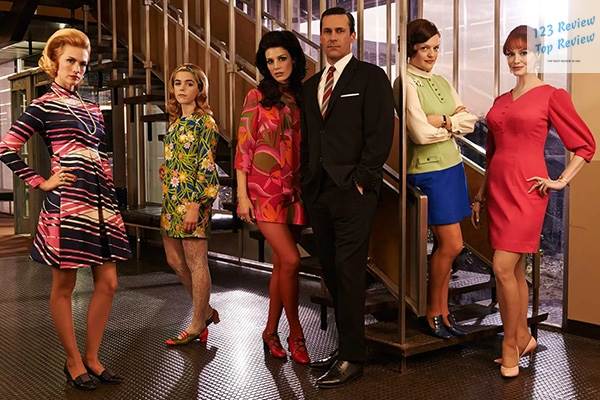Set against the backdrop of 1960s New York, it delves into the lives of advertising executives at Sterling Cooper. The show is celebrated for its meticulous attention to detail, complex characters, and exploration of significant societal themes.
The Setting of Mad Men
New York City in the 1960s
“Mad Men” is firmly rooted in the vibrant and transformative landscape of 1960s New York City. The city itself is a character, with its bustling streets, towering skyscrapers, and smoky bars creating an authentic atmosphere. Manhattan, particularly Madison Avenue, is depicted as the epicenter of the advertising world, capturing the energy and ambition that defined the era. The meticulous set designs, from the sleek offices to the characters’ stylish homes, immerse viewers in the period’s aesthetic and social dynamics.

The Cultural Landscape
The 1960s were a time of significant social upheaval and cultural evolution in the United States. “Mad Men” reflects these changes, portraying the rise of counterculture movements, the fight for civil rights, and the shifting roles of women. The show addresses pivotal historical events, such as the assassination of John F. Kennedy, the Vietnam War, and the moon landing, weaving them seamlessly into the characters’ lives. This contextual richness provides a multifaceted view of an era marked by both progress and conflict.
Advertising Industry Overview
At the heart of “Mad Men” is the advertising industry, a world of creativity, persuasion, and relentless competition. The series offers a behind-the-scenes look at how ad campaigns are conceived, pitched, and executed, highlighting the industry’s influence on consumer behavior and cultural norms. Through the lens of Sterling Cooper, viewers gain insight into the ethical dilemmas, power struggles, and innovative strategies that drive the advertising world. The portrayal of iconic ad campaigns and the creative process underscores the industry’s significance in shaping public opinion and societal values.
Main Characters and Development
Don Draper: The Enigmatic Hero
Don Draper, played by Jon Hamm, is the enigmatic and deeply flawed protagonist of “Mad Men.” As a brilliant and charismatic ad executive, Don’s professional success contrasts sharply with his tumultuous personal life. The character’s journey is marked by his efforts to reconcile his troubled past with his present identity. Don’s struggles with infidelity, identity, and existential despair make him one of television’s most complex and compelling figures. His ability to reinvent himself, both professionally and personally, serves as a central theme throughout the series.
Peggy Olson: Breaking Barriers
Peggy Olson, portrayed by Elisabeth Moss, begins her journey as Don’s secretary and evolves into a trailblazing copywriter. Peggy’s character arc is emblematic of the changing roles of women in the 1960s workforce. Her determination to break free from traditional gender roles and assert her creative talents reflects the broader feminist movement of the era. Peggy’s relationships, professional triumphs, and personal sacrifices highlight the challenges and rewards of being a pioneering woman in a male-dominated industry.
Joan Holloway: Femininity and Power
Christina Hendricks brings to life Joan Holloway, the office manager whose beauty and competence command attention. Joan’s character navigates the delicate balance between leveraging her femininity and asserting her authority in the workplace. Her journey from office manager to partner showcases her resilience, intelligence, and strategic acumen. Joan’s personal and professional struggles, including dealing with sexism and seeking respect, provide a nuanced exploration of power dynamics and gender politics.
Roger Sterling: The Charming Executive
Roger Sterling, played by John Slattery, is the charming and hedonistic partner at Sterling Cooper. Known for his wit and charisma, Roger’s character often provides comic relief while also delving into deeper themes of legacy, mortality, and self-indulgence. His relationships with other characters, especially Don and Joan, reveal layers of vulnerability and complexity beneath his polished exterior. Roger’s professional decisions and personal escapades significantly impact the agency’s trajectory, adding to the show’s dynamic narrative.
Pete Campbell: The Ambitious Young Man
Vincent Kartheiser portrays Pete Campbell, an ambitious and often ethically ambiguous account executive. Pete’s relentless pursuit of success and recognition drives much of his character’s actions, leading to both professional triumphs and personal conflicts. His complex relationship with Don, marked by both admiration and rivalry, underscores the generational and ideological differences within the agency. Pete’s character embodies the tensions between ambition, morality, and the desire for validation in the corporate world.
Key Themes Explored
Gender Roles and Feminism
“Mad Men” offers a profound exploration of gender roles and the feminist movement of the 1960s. The series portrays the limitations and expectations placed on women, from the workplace to the home. Characters like Peggy and Joan navigate these challenges, striving for equality and recognition in a male-dominated environment. The show highlights the evolving roles of women, the rise of feminist consciousness, and the push for societal change.
The American Dream and Capitalism
The pursuit of the American Dream is a central theme in “Mad Men.” The characters’ relentless quest for success, wealth, and personal fulfillment often leads to moral and ethical dilemmas. The show critiques the superficiality and excesses of capitalism while exploring the deeper meaning of happiness and success. Through the lens of the advertising industry, “Mad Men” examines the promises and pitfalls of the American Dream.
Identity and Self-Discovery
Identity is a recurring theme, with characters constantly grappling with who they are and what they want. Don Draper’s secret past and dual identity serve as a focal point for this exploration. The series delves into how personal and professional identities intersect and evolve, highlighting the complexities of self-discovery. Characters struggle with societal expectations, personal desires, and the need for reinvention.
Change and Resistance in Society
“Mad Men” captures a society in flux, with characters responding to the rapid changes of the 1960s in various ways. Some embrace progress and adaptation, while others resist and cling to traditional values. The series explores the tension between change and resistance, reflecting the broader societal shifts of the era. This dynamic creates a rich and layered narrative, showcasing the opportunities and challenges that come with societal transformation.
Narrative Structure and Style
Non-linear Storytelling
“Mad Men” employs non-linear storytelling, using flashbacks and time jumps to reveal character backstories and motivations. This narrative technique adds depth and complexity to the plot, allowing viewers to piece together the characters’ histories and understand their present actions. The show’s intricate narrative structure keeps audiences engaged, providing a multifaceted view of the characters’ lives.
Cinematography and Visual Style
The show’s cinematography and visual style are meticulously crafted to evoke the 1960s. The use of color, lighting, and period-accurate set design creates an authentic and immersive viewing experience. From the stylish offices of Sterling Cooper to the characters’ homes and social settings, every detail is designed to transport viewers back in time. The visual aesthetics of “Mad Men” contribute significantly to its storytelling, enhancing the mood and tone of the series.
Use of Music and Soundtrack
Music plays a crucial role in “Mad Men,” with a carefully curated soundtrack that reflects the era’s cultural zeitgeist. From iconic 1960s hits to mood-setting instrumental pieces, the show’s music enhances the emotional impact of scenes and underscores the themes explored. The soundtrack not only sets the tone but also provides a deeper connection to the time period, making it an integral part of the viewing experience.
Impact and Legacy of Mad Men
Critical Reception and Awards
“Mad Men” received widespread critical acclaim and numerous awards throughout its run, including multiple Emmys and Golden Globes. The show’s writing, acting, and production values were consistently praised, solidifying its status as one of the greatest television series of all time. Critics lauded its character development, thematic depth, and historical accuracy, contributing to its enduring legacy.
Influence on Modern Television
The success and innovative storytelling of “Mad Men” have influenced a new generation of television creators. The series set a high standard for character-driven dramas and period pieces, inspiring many subsequent shows to explore similar themes and narrative techniques. Its impact can be seen in the increased focus on character complexity, historical settings, and nuanced storytelling in modern television.
Cultural Commentary and Analysis
“Mad Men” has sparked extensive cultural commentary and analysis, with scholars and critics examining its portrayal of the 1960s and its relevance to contemporary issues. The series continues to be a subject of discussion in academic and popular media, reflecting its profound influence on cultural discourse. Its exploration of gender, identity, and societal change provides valuable insights into both the past and present.
Major Story Arcs
The Rise and Fall of Sterling Cooper
The evolution of the Sterling Cooper advertising agency, from its peak to its challenges and transformations, serves as a central storyline. The business dynamics, mergers, and leadership changes provide a backdrop for the characters’ personal and professional growth. The agency’s rise and fall mirror the broader societal shifts of the 1960s, creating a compelling narrative arc.
Don’s Personal Struggles
Don Draper’s personal struggles, including his secret past, infidelity, and search for meaning, drive much of the series’ drama. His complex relationships and internal conflicts offer a deep exploration of identity and redemption. Don’s journey is marked by moments of triumph and despair, reflecting the show’s central themes of self-discovery and reinvention.
The Changing Dynamics of the Agency
The shifting power dynamics within the agency, influenced by societal changes and personal ambitions, create ongoing tension and intrigue. Characters’ alliances, betrayals, and professional rivalries shape the agency’s evolution. The series highlights the impact of external events, such as mergers and acquisitions, on the characters’ lives and careers.
Relationships and Betrayals
“Mad Men” is rich with interpersonal relationships, from romantic entanglements to friendships and professional partnerships. The series examines the complexities of love, loyalty, and betrayal, providing a nuanced look at human connections. Characters’ personal lives are intricately woven into the professional landscape, creating a multifaceted narrative.
Social Issues Addressed
Racism and Civil Rights
The series addresses issues of racism and the Civil Rights Movement, highlighting the struggles and progress of African American characters. It provides a lens through which to view the era’s social justice challenges and triumphs. The portrayal of racism, both subtle and overt, adds depth to the narrative and reflects the societal tensions of the time.
Mental Health and Substance Abuse
Characters in “Mad Men” grapple with mental health issues and substance abuse, reflecting the era’s attitudes and treatments. The series offers a sensitive and realistic portrayal of these struggles, contributing to broader discussions on mental health. The depiction of alcoholism, depression, and anxiety underscores the show’s commitment to exploring complex and often stigmatized issues.
Divorce and Family Dynamics
The impact of divorce and evolving family dynamics is a recurring theme in “Mad Men.” The show explores the changing nature of marriage, parenthood, and family life in the 1960s, offering a poignant look at personal relationships. Characters’ struggles with fidelity, parenting, and domestic expectations provide a rich and emotional narrative layer.
Behind the Scenes
Creator Matthew Weiner’s Vision
Matthew Weiner, the creator of “Mad Men,” envisioned a series that would authentically capture the complexities of the 1960s. His attention to detail and commitment to character-driven storytelling were instrumental in the show’s success. Weiner’s vision and leadership shaped the series’ narrative and aesthetic, ensuring its historical accuracy and emotional depth.
Casting Choices and Their Impact
The casting of “Mad Men” was crucial to its success, with actors like Jon Hamm, Elisabeth Moss, and Christina Hendricks delivering standout performances. The chemistry and talent of the cast brought depth and nuance to the characters, enhancing the series’ storytelling. The casting choices not only defined the characters but also contributed to the show’s critical acclaim and cultural impact.
The Production Process and Challenges
Producing “Mad Men” involved significant challenges, from recreating the 1960s to maintaining historical accuracy. The production team’s dedication to authenticity and quality contributed to the show’s critical acclaim and lasting legacy. The meticulous attention to detail in set design, costumes, and props ensured an immersive and believable depiction of the era.
In conclusion, “Mad Men” is a groundbreaking series that offers a profound exploration of the 1960s through its rich characters, intricate storytelling, and thematic depth. Its impact on television and cultural commentary continues to resonate, making it a timeless classic. The series’ exploration of identity, societal change, and personal struggles provides valuable insights into both the past and present, cementing its place as a landmark in television history.





